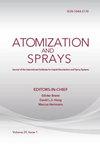涡致柱状空化对柴油喷射喷嘴内流动和喷雾特性影响的研究
IF 0.9
4区 工程技术
Q4 ENGINEERING, CHEMICAL
引用次数: 0
摘要
柴油机燃油喷射系统在很大程度上依赖于喷油器的精确操作,喷油器是公认的基础部件。影响喷嘴流动能力和喷射性能的关键因素是喷嘴内部流动特性。本文采用高速成像、粒子成像测速技术和数值模拟相结合的方法研究了喷油器喷嘴内涡激空化现象。结果表明,注入压力的增加会导致管柱空化强度的增加,从而减少有效流动面积,影响内部流动能力。重要的是,我们的研究证实,尽管在高压下空化现象加剧,但管柱空化不会造成严重的侵蚀损害。相反,在喷嘴内的旋流作用下,它通过将燃料注入旋转状态,在促进燃料雾化方面起着关键作用。此外,我们的观察还揭示了针孔管柱空化和井孔管柱空化的显著区别。具体来说,与普通井串空化相比,针孔串空化产生的喷射角度更大。然而,必须注意的是,前者表现出速度场分布均匀性的降低和射流雾化效应的减弱。总之,这项全面的研究为复杂的管柱空化机制提供了有价值的见解。通过对流动特性、侵蚀效应和雾化过程的详尽探索,我们的工作对燃油喷射领域做出了重大贡献本文章由计算机程序翻译,如有差异,请以英文原文为准。
Investigation of the Effects of Vortex-Induced String Cavitation on Flow and Spray Characteristics within Diesel Fuel Injection Nozzles
The diesel fuel injection system relies heavily on the precise operation of the fuel injection nozzle, universally recognized as its foundational component. A key factor significantly affecting both flow capacity and injection performance is the internal flow characteristics of the nozzle. This study investigates the vortex-induced string cavitation within fuel injector nozzles by incorporating high-speed imaging, particle image velocimetry techniques, and numerical simulations. The results demonstrate that an increase in injection pressure precipitates an escalation in string cavitation intensity, thus reducing the effective flow area and compromising internal flow capacity. Importantly, our study confirms that, despite its intensified occurrence under higher pressure, string cavitation does not cause significant erosion damage. Instead, it plays a pivotal role in promoting fuel atomization by injecting it into a rotational state, facilitated by the cyclonic action within the nozzle. Furthermore, our observations reveal a notable distinction between needle-hole string cavitation and hole-hole string cavitation. Specifically, needle-hole string cavitation produces more extensive spray angles compared to hole-hole string cavitation. However, it is crucial to note that the former exhibits reduced uniformity in the distribution of velocity fields and a weakening of the jet atomization effect. In conclusion, this comprehensive study provides valuable insights into the intricate mechanisms of string cavitation. Through an exhaustive exploration of flow characteristics, erosion effects, and atomization processes, our work significantly contributes to the field of fuel injection
求助全文
通过发布文献求助,成功后即可免费获取论文全文。
去求助
来源期刊

Atomization and Sprays
工程技术-材料科学:综合
CiteScore
2.10
自引率
16.70%
发文量
54
审稿时长
1.7 months
期刊介绍:
The application and utilization of sprays is not new, and in modern society, it is extensive enough that almost every industry and household uses some form of sprays. What is new is an increasing scientific interest in atomization - the need to understand the physical structure of liquids under conditions of higher shear rates and interaction with gaseous flow. This need is being met with the publication of Atomization and Sprays, an authoritative, international journal presenting high quality research, applications, and review papers.
 求助内容:
求助内容: 应助结果提醒方式:
应助结果提醒方式:


